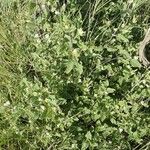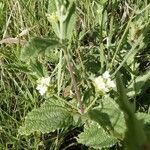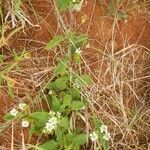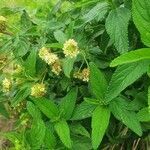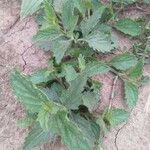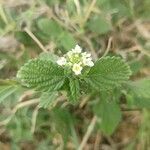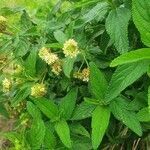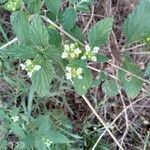Shrub or subshrub 0.3–2.5 m. tall, occasionally scrambling; branches with adpressed short upwardly directed hairs, at length ± glabrous and roughened with distinctly raised petiole-bases.. Leaves almost always opposite, but occasionally in whorls of 3, ovate to ovate-lanceolate, elliptic-oblong or elliptic-lanceolate, 1.5–2.5(–12) cm. long, 0.7–4(–7) cm. wide, acute to ± obtuse at the apex, rounded then attenuate-cuneate into the petiole at the base, regularly coarsely to finely somewhat rounded crenate, not to distinctly discolorous, pubescent with ± tubercle-based hairs above and somewhat scabrid, pubescent to velvety or tomentose beneath; petiole up to 1.5 cm. long.. Peduncles solitary, rarely paired, (1.5–)2.5–13.5 cm. long, shorter than to usually longer than the subtending leaf, shortly pubescent; heads 0.7–1.5 cm. long, 1.1–2.5 cm. wide, mostly wider than long but elongating in fruit to 1.5–3 cm. or occasionally much longer, to 5 cm. in some forms; lower bracts rounded to broadly ovate or rarely oblong-ovate, 0.6–1.4(–1.5) cm. long, (3–)5–9 mm. wide, ± acuminate to less often long-acuminate or obtuse, equalling or exceeding the upper corollas at flowering but shorter than fruiting spikes, pubescent and glandular to densely velvety tomentose, sometimes strongly ribbed in fruit.. Calyx 2 mm. long, undulate, thinly pubescent.. Corolla predominantly white or sometimes pink; tube 5.5 mm. long; limb ± 5 mm. wide; lower lip 3.5 mm. wide.. Drupes lilac-purple, rhomboid-subglobose, 2.5–3.5 mm. long.
More
A shrub. It can be scrambling and can grow to 5 m high. The small branches have thorns. The leaves are opposite. The flowers are white.
Aromatic straggling subshrub or woody herb to about 3 ft. high
Peduncles long, usually exceeding the leaves
Flowers relatively large, white.
